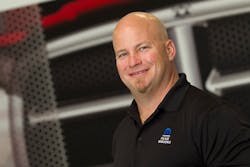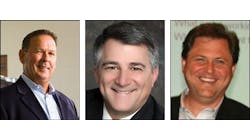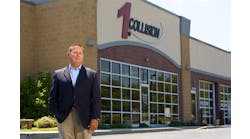When Brian Milosch saw the building, he knew.
“That was sort of my a-ha moment,” he says.
Milosch owns Milosch’s Palace Chrysler, Jeep, Dodge, Ram in Lake Orion, Mich. with his two brothers. He was on the hunt for a facility to house the dealership’s parts wholesale business, when he came across a 61,000-square-foot warehouse just down the street from the dealership.
The building was much larger than he needed, but then it hit Milosch—in addition to using it for parts storage, the building could serve as a new home for the dealership’s body shop, Milosch’s Palace Collision Center.
The current collision center was small and poorly designed, which congested workflow. Milosch was running two shifts a day to keep up with demands. The new building could give the collision center the upgrade it needed. It was big enough to handle its current work with plenty of room to grow.
But there was one problem: The facility was a brownfield site, a government designation meaning the area may be contaminated with hazardous waste.
Milosch, never one to shy away from a challenge, was not intimidated by the potential risks the site could bring. He pulled the trigger and embarked on a monumental renovation.
Milosch converted the former brownfield site into a top-of-the-line shop with enhanced workflow, sparkling surfaces, and an array of efficiency measures, taking the location from environmental hazard to an operation built on quality care and cost-reducing efficiency.
Oil Spill
The building was the former home of Royal Oak Boring, a Michigan-based company that did high-speed drilling and lathing in the warehouse. When Milosch bought the building, he found it coated in oil—the reason for the brownfield designation.
“The oil was actually dripping off the ceiling when we bought this place,” Milosch says. “It was bad.”
Milosch hired a company that specialized in industrial cleaning to wash everything with abrasive detergent and vacuum all the runoff to prevent further contamination. They then painted all the surfaces with oil-encompassing paint to prevent any traces from leaking through.
Milosch contracted a multitude of other companies—cement, demolition, roofing, etc.—to help with the renovation.
The project was monumental. Milosch estimates that at one time, there were over 20 cranes working on the building. They completely gutted it, removing 40 dumpsters worth of piping and scrap metal.
Even more astonishing than the sheer scale of the project was how quickly it got done. Construction started Sept. 1, 2010. Milosch and his crew moved into the building Dec. 30, 2010.
“I had guys working 24 hours [a day],” he says. “When it was done, it looked like a hospital. It was beautiful.”
First-Class Design
Like a hospital, Milosch’s No. 1 concern is quality care, and the first way in which the new facility allows for a higher level of care is through its shop layout.
The old shop was 5,000 square feet, too small for the volume of work the dealership demanded, and it had a design that prevented continuous workflow. Cars needed to be backed in and out of the shop to transfer them between departments. It wasted time and limited throughput.
The new facility measures out to 35,000 square feet—a massive expansion—but Milosch was confident he could attract the work to fill the additional space. Since there is no other shop like it in the area, it benefits from what Milosch refers to as the “Disney Effect.”
“When something is so much larger, so much nicer, so much newer, it’s got to be better,” Milosch says. Milosch advertised his newer, better collision center in all of the local papers. And once he had the community’s attention, he knew the new facility’s layout would allow his crew to work efficiently to deliver quality repairs.
Milosch constructed the repair process in a circle. During a repair, the car rotates around the circle, progressing through departments—body to paint to reassembly. The intention is that once the car makes a full loop, it’s completely repaired. There are no bottlenecks, just continuous workflow.
Brian Boreo, collision center manager, says the shop layout helps the staff accomplish its primary goals: “What we’re trying to go for is customer satisfaction and cycle time,” he says.
Right now, the shop has a cycle time of four days, and Milosch estimates they hit their delivery dates more than 95 percent of the time. The collision center is currently doing $450,000 per month in sales, an increase of 35 percent compared with the old shop, according to Milosch.
A Polished Finish
While layout is the backbone of the new facility, cleanliness and customer amenities take the shop to another level.
One of Milosch’s least favorite features of any body shop: the dust.
“Normally when you go into a body shop, there’s just that hanging cloud,” Milosch says. “It’s just nasty, and everything is totally covered in dust even if it sits out for an hour.”
To fix this, Milosch invested in a Eurovac system, which attaches to each technician’s sanding unit. The dust is sucked through the sand paper into the vacuum system. The vacuum eliminates the dust in the air, improving employee health.
With a dust-free shop, all of the surfaces sparkle. Milosch invested in T5 lighting, an energy-efficient, fluorescent lighting system that makes the shop as bright as possible. To maintain a consistent shine, Boreo says they clean the floor with a riding polisher three times a day.
Outside the shop floor, the waiting area offers an array of amenities to customers. Of course, Milosch provides the regular accommodations—coffee, Wi-Fi and TV—but he also installed a 180-gallon saltwater fish tank, which is a hit among kids.
“The kids will literally just sit there for hours to find all the little critters walking around the reef in it.”
He gives shop tours to customers or local organizations about once a week.
“They’re very intrigued by the shop,” Milosch says. “They’ve never seen a body shop this nice.”
And the awards serve as testaments. In the two years the new collision center has been open, the local newspaper has named it best body shop both years.
Beyond the Shine
The shop is more than polished surfaces. Milosch researched and installed a series of efficiency measures, which have significantly reduced costs.
From the get go, Milosch looked into different programs that would help him pay for some of the features he wanted to put in place. For example, he received a federal grant to place solar panels on his roof, which he estimates produces 10 to 12 percent of the building’s total electricity every month. He also got money from the local electrical company for installing the efficient T5 lighting. He says that most energy companies offer some sort of credit for businesses who wish to install low-energy lighting.
Milosch also invested in a new heating unit, which burns the old waste oil from the dealership’s mechanical shop to generate heat.
“There is really no smoke,” Milosch says. “It burns incredibly clean.”
The unit, which cost Milosch around $8,900, heats the entire parts storage area as well as the estimating bays, a space totaling around 20,000 square feet. Milosch says it’s hard to determine exactly how much money it saves him, but he estimates it would cost $1,500 a month to heat the area using traditional methods.
In addition to the waste oil, Milosch developed another unique heating method. The Eurovac system is constantly running and generating heat, so Milosch ventilates the heat from the vacuum into the wash bays. Although there is a propane grid that provides supplemental heating in the wash bays, Milosch says a majority of the heat comes from the Eurovac.
One of Milosch’s biggest money savers, however, is recycling. He bought a refurbished baler for $8,500 and now bales all of the collision center’s cardboard and soft plastic waste. Before recycling, Milosch would go through three dumpsters of trash every two months, mostly filled with cardboard. He would pay a private company $350 to remove each dumpster. Now with the baler, he goes through one dumpster every six months and gets paid around $1,400 a month, selling his recycled materials.
With the money he’s saved from recycling, Milosch decided to add one final touch to his top-of-the-line shop—an employee gym. Milosch put together a 2,500-square-foot workout facility complete with showers and a personal trainer who visits a few times a week. With a facility designed to offer so much value to customers, Milosch says it felt good to give something back to his employees.
“[It] gets used all the time now,” Milosch says. “Everybody is healthier and happier.”



